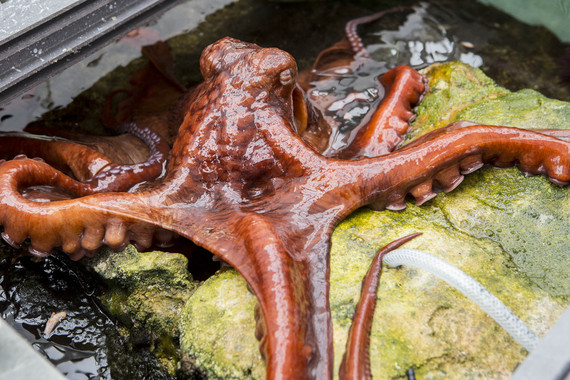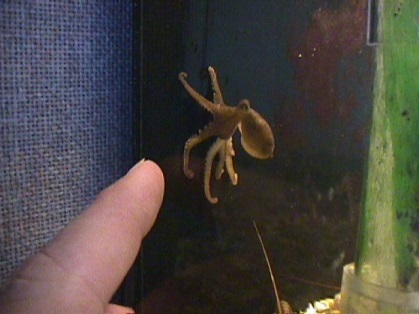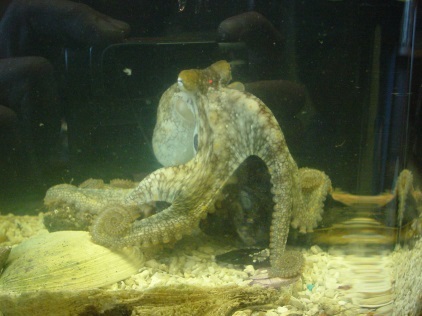October 8 to 12 marks Cephalopod Awareness Days, a time to appreciate and learn about these fascinating - and often mysterious - aquatic creatures. If you find yourself wondering exactly what a cephalopod is, don't get your tentacles in a bunch. In my decades of experience in veterinary medicine, I've had the privilege of spending quite a bit of time with the animals, and wanted to share some things I've learned - as well as some things these curious creatures keep the animal care community guessing.
So, what exactly is a cephalopod, anyway?
The word cephalopod comes from the ancient Greek and means "head foot". They are a group of most amazing animals that includes octopuses (or octopi, octopoids or octopoda), cuttlefishes, squids and nautilus. There are thought to be around 800 species of cephalopods in existence today; each phenomenal in their own right.
Phenomenal?
For example, take the octopus. Octopuses are global in distribution ranging from the tiny highly venomous Australian Blue-ringed octopus of the genus Hapalochlaena to the Giant Pacific octopus, Enteroctopus dofleini, like Oliver who lives here at Shedd Aquarium. Blue-ringed octopuses although small in size, are highly venomous and bites can be fatal to humans. On the other hand, the Giant Pacific Octopuses are not venomous at all.
These animals are invertebrates; animals with no backbone. Spineless creatures that they are, they possess some of the most amazing personalities in the animal kingdom. They are fast learners and quick to discover solutions to problems. They can be trained to perform a number of simple tasks and have been observed to use tools even in native environments. They have elaborate communication mechanisms and rituals often utilizing changing color and texture patterns of their skin. Specialized cells in the skin instantly change tone producing elaborate waves of patterns sending messages to friends and foe alike.
Color changing? What's that look like? And what use is it to a cephalopod?
It can be for a variety of reasons, really. I once saw a male cuttlefish in a research aquarium position himself between another male and a female. On one side, the side facing the other male, a menacing pattern of dark bands flashed along the body sending a message, I assume, of his claim over the female. Along the side facing the female, a dazzling array of reverberating spots, likely to show off for her. Certainly, this was the cuttlefish's equivalent of some sort of sexual social posturing.
Years ago, I also raised a baby octopus that would regularly follow my finger around the desktop aquarium. While he did this, he was alternately getting puffed up with spikey skin then flattening out his entire surface smoothly - what Spike was trying to tell me, I'll never know.
So, Octopi. Why so many arms? How can you tell them apart?
The physical structure of these animals' bodies are highly specialized and super fascinating. All have arms or appendages are known as tentacles, and the octopus famously has eight. Scientists who study these animals number the tentacles in a standard format. For an octopus, looking down on the animal from above, the arms are numbered one through four on each the right and left sides starting at the ones closest to the eyes.
This is important because one tentacle, the right-third, in the male has a modification to the "suckers" on the very end, which is how one tells a male from a female octopus from the outside. That modification is called the hectocotylus and is used for - you guessed it - delivery of a packet of sperm, a spermatophore, to the female during reproduction. That whole process is an elaborate synchronized dance during which the male appears to coax the female into accepting his gift and she very obviously has some say so in the matter. If she accepts, she gracefully allows the male to place the sperm packet into her body and hundreds of baby octopus eggs result.
They sound pretty smart. Is there anything else that sets them apart?
Another fascinating capability of some octopuses is mimicry - they can shape-shift to look like all sorts of critters or inanimate objects in their pursuit of prey and frivolity along the ocean floor. Video clips of coral heads that all of a sudden "come alive" as an octopus show up with some regularity on YouTube and other channels. Browsing the web will produce lots of cool examples of octopuses looking like something they are not.
Sounds like you have quite a bit of experience. Do you have some favorite stories?
Over my many years of practice as an aquatic animal veterinarian I have had the great pleasure and privilege of having some octopuses as patients. One of my favorites was a case I saw when I worked at a seaside facility along with some divers. One day the divers brought me an octopus they had found and asked what I could do for it. One of the animal's legs had been injured, was shortened and a bit misshapen from the wound. I still remember they named the animal Marilyn - after Marilyn Monroe - because they wanted her to feel like she had great legs. Their encouragement seemed to help because Marilyn made a full recovery and was released back to her ocean home after a short stay in an aquarium on my desk. The injured leg remained a little short but she had seven others and I thought all of her legs looked fantastic.
Bill Van Bonn, DVM, is Shedd Aquarium's vice president of animal health. With more than 25 years of clinical veterinary experience, Dr. Van Bonn strengthens the aquarium's established animal care and health expertise, overseeing its diverse aquatic medicine initiatives as well as furthering innovative veterinary science at Shedd. Dr. Van Bonn specializes in preventive medicine and enhanced clinical veterinary services for aquatic animals, with a focus on marine mammals. At Shedd, he focuses on providing top-quality care and applying his knowledge of animal health to conservation of their counterparts in the wild.


